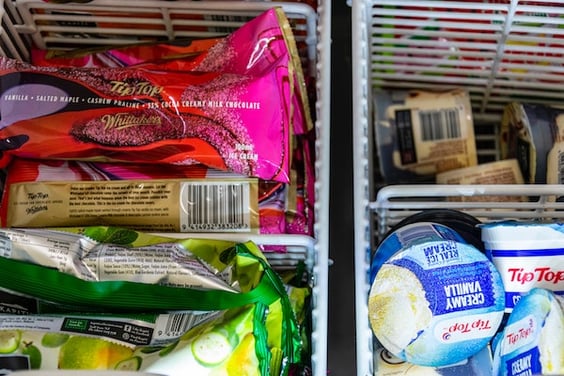The performance that supermarkets are able to manage and pull off every year, all year round, is quite remarkable. With customers that come in and out every day to purchase very different items, shelves get emptied at random rates, but a magical wand seems to almost always restock them on time. Certain items like butter or paper towels should follow a very constant demand over time, but many other products can vary drastically from week to week. Interestingly enough, it’s not always the ones we have in mind.
It’s not just all about ice cream when the warmth comes back. You need to take into account that a retailer might own stores in a very wide territory, demand per store will also vary. Ice cream demand in the Vancouver branch won’t be the same as in the Miami one. We just took one example for a quick illustration, but we can multiply this by the vast diversity of products a supermarket sells, which quickly escalates to big data.

More than seasonal changes, it’s the many imperceptible changes of trends for certain products that will make supermarkets win or lose customers (for offering a constant supply of products while minimizing stock). The ability to accurately forecast demand is largely understood in the retail industry, and many other businesses rely on it to operate and monitor their business efficiently. Integrating predictive analytics into the demand forecast of the supply chain can reduce errors from 20% to 50%, according to McKinsey. Subsequently, lost sales can be reduced by up to 65%. And supply chain is just one side of the potential of demand forecasting — workforce planning and hiring, marketing, as well as risk management or customer satisfaction can all be positively impacted by the anticipation of demand.
Playing With Factors of Demand
Factors could be a seasonal trend that invariably comes back a certain day of the year or a more subtle factor inherent to the demand for similar products or even production capabilities we can track internally.There are dozens (if not hundreds) of internal business indicators or external factors that can be taken into account to anticipate a surge or a drop in demand. Playing with two or three factors on a spreadsheet may be doable, but it soon becomes impossible when parameters are multiplied. That is where AI models come in handy — to get the most accurate model possible, while also testing potential drivers of demand in a relatively short amount of time.
Business questions that a demand forecast model can help answer can be very diverse, but here are a few examples:
- What will be the best sellers in three months?
- Why are the sales of some products declining?
- To which areas should the products be shipped to? In which quantities?
- How should I adjust the product purchasing strategy?
- Which marketing channels can help boost product purchases?
Depending on the questions that are trying to be answered, the model can be built to forecast on daily, weekly, or monthly time ranges. Models can be very impacted by this choice of range, hence the importance of this aspect.
Including a wide range of potential factors, making the choice of a specific time range, and being able to fine tune the results with powerful parametrization were the ideas we had in mind creating the solution. A demand forecast can be a powerful tool if shaped to the right context.
How Can Dataiku's Business Solutions Help You Reach Full Potential?
Business Solutions are Dataiku add-ons accelerating the way to achieve advanced or foundational industry-specific use cases within your organization. They are an operational shortcut to achieve real-world business value. Taking advantage of Dataiku’s core features, they are built to be fully customizable and entirely editable.
They come with:
- A user-friendly interface that enables fine tuning to match specific business requirements
- Ready-to-use dashboards that can be customized
- Documentation and training materials
Dataiku industry specialists develop solutions for every vertical, among which:
- Retail & CPG: Distribution spatial footprint, market basket analysis, RFM-enhanced customer lifetime value, product recommendation
- Financial services and insurance: Interactive document intelligence for ESG, modern insurance pricing, AML alerts triage
- Health and pharmaceuticals: Omnichannel marketing, accelerating drug repurposing
- Manufacturing and energy: Predictive maintenance, outliers detection
As a result, business professionals experience a boost in AI productivity and can rationalize their resources.
How Does It Work in Practice?
The Demand Forecast solution provides a reusable project to accelerate the development of analytics tailored to your data and business structure.
Learn more about Dataiku's Demand Forecasting solution in the video above.
With this solution, supply chain managers, marketing analysts, sales controllers, and inventory managers are able to:
- Create demand forecasts with all necessary datasets: transactions, SKU seasonality, store locations, and online/offline events (e.g., holidays, marketing, etc.).
- Consume the output and forecast the demand of specific product categories or SKUs through an interactive webapp and dashboards.
- Fine-tune the settings through a user-friendly Dataiku Application
From a user perspective, the solution is made of the following easy-to-use components:
1. An Interactive Webapp
Dynamically display the predictions performed by the demand forecast model with your chosen granularity.
2. Forecast Model Evaluation
Compute the model error as the difference between predicted and actual values.
3. Forecast Model Interpretation
Assess your model's most important variables and understand the relationship between your input features and your model predictions.
4. Seasonal Clustering
Assess the product/services' seasonality and learn seasonal clusters.
5. Sales Monitoring
Analyze your sales evolution over time.
Start forecasting the demand for your products right now, with these simple requirements:
- You can install this solution by downloading the .zip project file and uploading it directly to your Dataiku instance as a new project. The solution is currently in its beta version.
- Historic data on the past transactions, product information, and sales seasons
- Dataiku version: 10.0 or later




